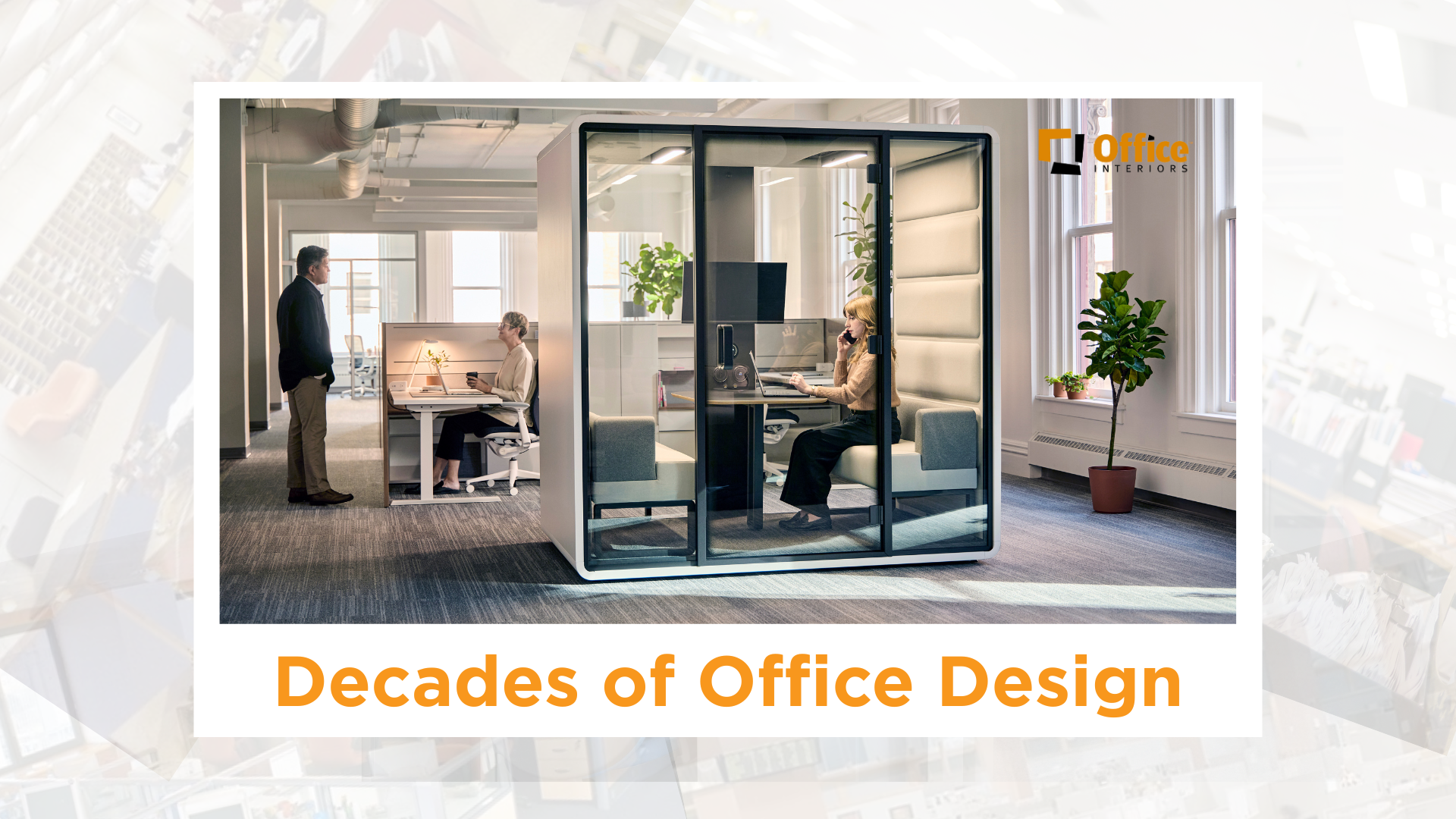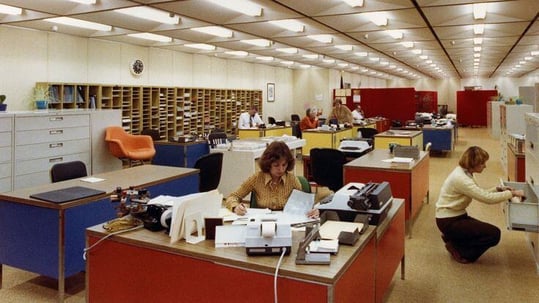Workplace Evolution: The History and Future of Office Design
October 21st, 2025 | 5 min read
By Fola Adedeji

Offices have changed in ways few could have predicted. From rigid and formal setups to flexible, hybrid-friendly spaces, the journey of office design mirrors shifts in work habits, technology, and culture. Each decade brought its own ideas about how people work best, and these ideas shaped everything from cubicle walls to the chairs we sit on. Understanding this evolution offers insights into why certain design choices remain relevant and how the office of the future might look.
TL;DR (Summary)
-
Office design has evolved from high-walled cubicles in the 1970s to flexible, hybrid-friendly spaces today.
-
Technology, from desktop computers to laptops and mobile devices, has shaped workstation size, layout, and furniture needs.
-
Cubicles have shrunk and adapted over time, balancing privacy, collaboration, and personal storage.
-
Hybrid work and hot-desking introduced shared, flexible workstations with central storage and adjustable furniture.
-
Modern offices combine adaptability, sustainability, and comfort to support diverse work behaviours and changing work patterns.
1970s: The Rise of Privacy and Ergonomic Design
The 1970s were a time of bold experimentation in office interiors. Bright colours and solid, geometric forms gave workspaces an energetic feel. Cubicles began to appear everywhere, providing employees with personal slices of privacy within larger office environments. These 81” high walls created spaces where workers could focus and store all their essential items.

A breakthrough during this decade was the introduction of ergonomic chairs. The Ergon chair, launched in 1976, was designed to support employee well-being with adjustable height and back support. Offices were evolving into environments that considered comfort as well as function, signalling the beginning of the human-centred design movement.
1980s: Technology Integration in Office Spaces
As the comfort-first mindset of the 1970s evolved, the 1980s ushered in a new era defined by technology. Personal computers became standard in workplaces, reshaping how offices were designed and organized. To accommodate bulky monitors, keyboards, and wiring, desks grew larger, and raised flooring systems were introduced to manage power and data cables.
Cubicles, once symbols of privacy, were adapted to suit these new needs. Designers began lowering panels to 65”, making spaces feel more open while retaining individual focus zones. Storage remained substantial to handle binders, files, and growing tech accessories. By the late 1980s, nearly half of employees used personal computers, and workplace layouts evolved around connectivity and equipment efficiency. This decade redefined productivity, merging ergonomics with early digital infrastructure and laying the foundation for today’s tech-integrated offices.

1990s: Open-Plan Offices and Modular Workstations
The 1990s marked a shift toward more openness. 66" cubicles became the norm, creating a sense of connectivity while still offering personal space. The footprint of a typical workstation shrank from 10 x 10 feet to 8 x 8. Storage requirements also began to decrease, reflecting the lighter load of materials and documents as digital tools started to reduce the reliance on paper.
Modular furniture became increasingly popular, allowing workspaces to adapt as teams and projects evolved. Personalization grew in importance, with employees focusing more on their individual items rather than maintaining large filing systems. Offices were moving away from a one-size-fits-all model toward spaces that could adjust to different working styles.
Late 1990s to 2000s: From Cubicles to Collaborative Offices
By the mid-1990s, cubicles with 51” walls and overhead storage became common. Work surfaces remained large, but the growing sense of openness reflected the desire for collaboration and flexibility. Storage began to serve dual purposes, dividing space and providing functional organization.
Entering the 2000s, a new aesthetic emerged. Wood and traditional casegood-style storage added a higher-end look and feel. Laptops and office servers allowed desks to shrink slightly while maintaining functionality. Storage now provided subtle boundaries between spaces, enhancing both privacy and design. Workstations became more than just places to work—they were statements of professionalism and attention to detail.

2010s: Human-Centred and Flexible Workspaces
The 2010s brought a residential influence. Credenzas and cabinets began dividing space in ways that accommodated multiple behaviours: filing, piling, or temporary dumping of items. Workstations evolved to reflect the varied needs of employees rather than enforcing a uniform approach.
Technology was no longer confined to desktop computers. Laptops, mobile devices, and personal phones allowed employees to work from different areas, and the focus on ergonomics continued with standing desks and adjustable chairs. Offices became vibrant hubs, incorporating cafes, wellness spaces, and greenery to promote well-being. Flexibility was central, and sustainability began to shape material choices and furniture design.
2015 to 2020: Hot-Desking and Hybrid Work Trends
By 2015, the concept of a “destination desk” was fading. Workstations became touchdown points rather than full-day offices, with storage primarily for personal items. Height-adjustable tables made their first appearance, reflecting the rise of active and dynamic work practices. Desks became temporary bases, supporting shorter stays and more collaborative behaviour.
By 2020, the footprint of individual workstations shrank further to an average of 6 x 6 feet. System furniture gave way to flexible, movable pieces. Teams and central storage replaced individual storage, reflecting how collaborative work had changed daily office behaviour. Employees were no longer tethered to one desk. Daily tasks could be performed anywhere, making the cubicle less of a focal point. Furniture was chosen for adaptability, technology integration, and the ability to support multiple types of work.

2023 and Emerging Trends: Reimagining the Modern Cubicle
Despite the hot-desking and minimal footprint trends, cubicles have not disappeared entirely. Emerging designs reintroduce privacy and structured work areas, combining elegance and flexibility. Modern cubicles incorporate varied heights, curved screens, and premium materials. Storage and space division respond to both heads-down work and collaborative needs.
The hybrid work model now shapes daily office behaviour. Employees spend part of the week in the office, requiring spaces that support solo focus, team meetings, and touchdown work. Flexible furniture, central storage, and technology-enabled workstations make it possible to accommodate shifting patterns. Energy-efficient devices and sustainable furniture allow offices to be environmentally responsible while remaining highly functional.
Cubicles have evolved from static boxes to versatile, stylish components of the office that support a range of tasks and preferences. The design reflects lessons learned from decades of office experimentation, ensuring that privacy, comfort, and functionality coexist with collaboration and flexibility.

Learning from the Past to Shape the Future
The evolution of office design shows that spaces must adapt to how people work, not the other way around. Each decade reflects changes in technology, culture, and employee needs, from high-walled cubicles to open-plan offices and hybrid work environments. Modern offices continue to balance privacy, collaboration, and flexibility while prioritizing well-being, sustainability, and efficiency.
The cubicle, once a symbol of isolation, now represents adaptability. Modern interpretations merge privacy with openness, style with function, and individual space with team collaboration. Today’s emerging designs prove that the best offices draw from the elements of the past to meet contemporary demands.
Looking ahead, the office of the future will likely become even more adaptive and human centred. Workplaces will increasingly integrate intelligent systems, sustainable materials, and spatial flexibility that evolves with both technology and employee behaviour. Designers and organizations have the opportunity and responsibility to craft environments that not only support productivity but also inspire connection, creativity, and long-term well-being. By embracing continuous change, tomorrow’s workplaces can remain as dynamic and resilient as the people who bring them to life.
At Office Interiors, we stay at the forefront of evolving office design trends, partnering with leading manufacturers who prioritize innovation, sustainability, and ergonomic excellence. Whether you’re reimagining your workspace or building a hybrid environment from the ground up, our team can help you create a space optimized for performance, comfort, and collaboration.
Frequently Asked Questions
How has office design changed over the decades?
Office design has evolved from rigid, formal layouts with high-walled cubicles to flexible, hybrid-friendly spaces. Each era reflects shifts in technology, culture, and how employees work best.
Why were cubicles introduced, and how have they changed?
Cubicles started as private workspaces to give employees focus and storage. Over time, they have adapted to openness, modularity, and now coexist with flexible workstations and collaborative layouts.
How has technology influenced workstations?
From desktop computers to laptops and mobile devices, technology has reshaped desk sizes, storage needs, and connectivity. Modern offices integrate devices seamlessly to support varied work behaviours and hybrid schedules.
What role does sustainability play in modern offices?
Sustainable materials, energy-efficient devices, and modular furniture allow offices to reduce waste, improve air quality, and support employee well-being while maintaining functionality and aesthetics.
How do modern offices support hybrid work?
Flexible layouts and technology-enabled workstations let employees move between focused tasks, meetings, and short-term work. Storage, adjustable furniture, and adaptable zones make spaces efficient and responsive to shifting patterns.
Fola is the Marketing Coordinator at Office Interiors. She creates content and drives digital marketing initiatives that help customers navigate workspace-related questions with confidence.
Subscribe to Our Blog
Contact Us
If you’re ready to start improving productivity, streamlining processes, and love the way you work through optimized workspaces and office technology, contact us today. Our team of experts is here to help!
Topics:

